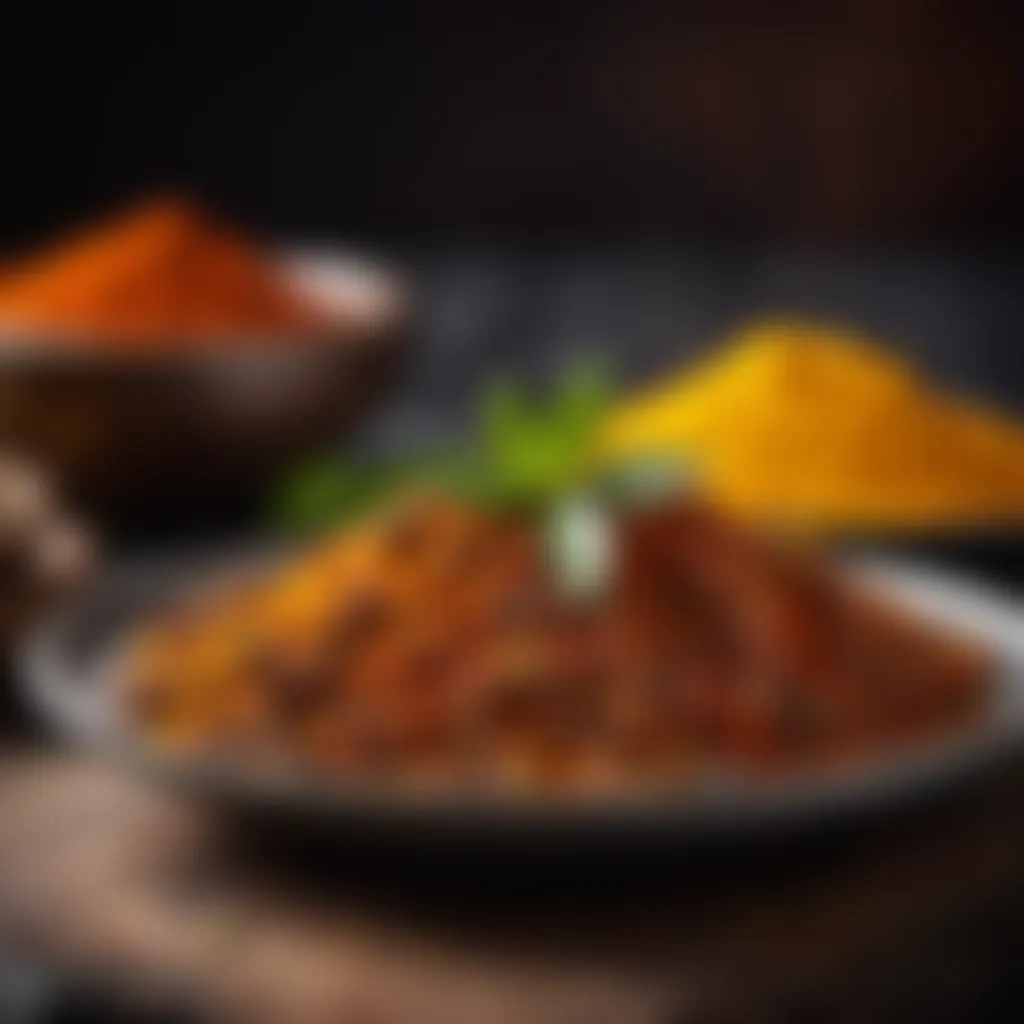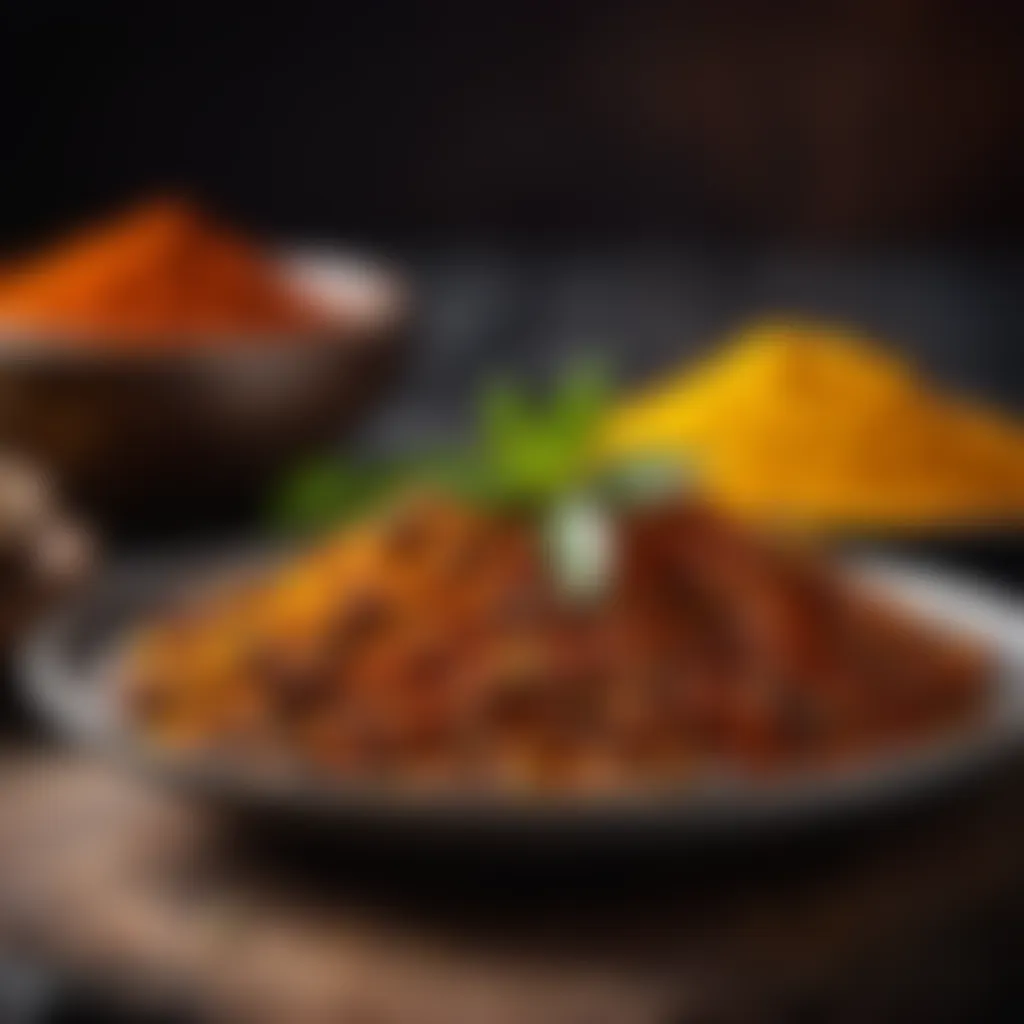Transform Your Pork Dishes with Innovative Recipes


Intro
Exploring the world of culinary arts often means peeling back layers of tradition and embracing innovation. This journey is particularly thrilling when it comes to preparing pork, a versatile meat that, when done right, can transform a meal into something extraordinarily memorable. Let's embark on a path that bends conventional wisdom and leads to an innovative recipe, enticing both the senses and the palate.
Pork has been a part of human diets for centuries. Yet, many home cooks often find themselves stuck in a rut, repeating similar recipes time after time. There's a wealth of potential waiting to be tapped—only limited by imagination and technique. This article aims to guide you through a creative approach to preparing pork, turning a simple dish into an experience worth savoring. From selecting the right ingredients to mastering the cooking process, you're about to dive into the nuances that elevate this beloved meat from mundane to magnificent.
With the right blend of spices, a few expert techniques, and a touch of flair, we will illuminate every step of the cooking journey, helping you build confidence in your kitchen. So, keep your apron at the ready, and let’s dive into the specifics starting with the vital foundation of any recipe:
Ingredients:
To craft an exemplary pork dish, you need the right tools in your culinary toolbox. Below is a straightforward list of ingredients that serves to enrich both the flavor and presentation. Here’s what you will need:
- 2 pounds of pork shoulder, trimmed and cut into 2-inch cubes
- 2 tablespoons of olive oil
- 1 tablespoon of smoked paprika
- 1 tablespoon of garlic powder
- 1 tablespoon of onion powder
- 1 teaspoon of cumin
- 1 teaspoon of dried oregano
- Salt, to taste
- Black pepper, to taste
- 1 cup of chicken broth
- 1 tablespoon of apple cider vinegar
- Fresh parsley, chopped for garnish
"Good cooking is all about using the right ingredients to draw out the best flavors."
The quality of the pork matters immensely. Opt for a well-marbled shoulder cut for a more succulent outcome. As for the spices, they should be fresh; old spices lose potency. Check your pantry—if they’ve been there longer than six months, it may be time for an upgrade.
Having all of these ingredients gathered ensures you can tackle the recipe seamlessly. Next, let’s get into the preparation steps, which sets the stage for our culinary masterpiece.
Prologue to Innovative Pork Cuisine
Pork has long been a cornerstone of culinary traditions across the globe. Its rich flavors and diverse cuts allow chefs and home cooks alike to experiment and create dishes that allure the senses. Exploring innovative pork cuisine is more than just cooking; it’s about embarking on a culinary journey—a journey that both enhances the dish and elevates the dining experience. As we dive into this exploration, it's crucial to grasp the concept of innovation in the realm of pork cookery.
Understanding Pork's Culinary Versatility
Pork offers a unique adaptability that can easily cater to various tastes and cooking styles. From the hearty, flavorful belly cuts to the lean chops, each part of the pig brings something different to the table. One might say that pork can be like a blank canvas, ready to absorb flavors from marinades or spices, allowing for a broad spectrum of culinary expressions.
- Variety of Cuts: Different cuts such as the tenderloin, shoulder, and ribs lend themselves to distinct preparations. For instance, while pork belly shines when braised, a pork loin is perfect for roasting.
- Cultural Influences: From the smoky flavor of barbecue to the aromatic spices of an Asian stir-fry, pork can fit comfortably into almost any global culinary theme.
- Complementary Ingredients: This meat harmonizes beautifully with a wide range of ingredients—think sweet apples, tart mustard, or a spicy salsa. Experimenting with these combinations can lead to unexpected yet delightful outcomes.
By understanding the versatility of pork, cooks can confidently craft dishes that surprise and satisfy.
The Rise of Modern Cooking Techniques
The world of cooking has seen a notable shift in techniques that open the door to creativity and precision. As we embrace modern cooking techniques, the ways we prepare pork have evolved significantly. What’s old is new again, with methods such as sous-vide, smoking, and pressure cooking taking center stage. These techniques not only improve flavor but also enhance texture, bringing out the best in pork dishes.
- Sous-Vide Cooking: This method involves vacuum-sealing food and cooking it in a water bath at a precise temperature. With pork, this ensures that every bite is juicy and tender, while flavors meld beautifully.
- Smoking: Adding a smoky depth through different wood types can transform pork into a dish that feels warm and inviting. This time-honored technique can be adapted with various woods for tailored flavors.
- Pressure Cooking: Ideal for busy households, pressure cooking can reduce cooking time dramatically without compromising the richness of the flavors. It’s like having a culinary shortcut that doesn’t skimp on satisfaction.
As cooks adopt these modern techniques, pork is poised to reach new heights, allowing for innovation while honoring traditional practices.
"With pork, the only limit is your imagination—so let’s think outside the box and create masterpieces that will leave everyone talking!"
In summary, innovative pork cuisine is about recognizing the excellent versatility of the meat and embracing the techniques that make cooking less daunting and more rewarding. This understanding sets the stage for a truly delightful culinary journey.
Selecting Quality Pork
Choosing the right pork is a fundamental step in achieving that sublime dish you have in mind. It’s not just about the flavor; quality pork will interact better with your cooking methods, resulting in a more appealing dish. Fresh, high-quality pork offers advantages you can taste—better marbling for juiciness, enhanced texture, and a richer, more complex flavor. The significance of this selection also extends to health considerations, as certain pork options are leaner than others, catering to dietary preferences.
Different Cuts and Their Uses
When it comes to pork, understanding the various cuts can help you make informed decisions while shopping. Each cut has its own unique qualities and ideal cooking methods.
- Loin: Known for its tenderness, pork loin is a versatile cut. Great for roasting, grilling, or making chops. If you want juicy, flavorful meat, this is a solid go-to.
- Shoulder: Often tougher than loin, pork shoulder excels when slow-cooked. Think pulled pork or stews; this cut rewards patience.
- Belly: A true treasure when seeking richness. Pork belly is fatty and flavorful, perfect for braising or frying, adding silky textures to your dishes.
- Ribs: Infamous for their mouth-watering flavor, especially when seasoned or marinated properly. Ideal for barbecuing or baking.
- Tenderloin: This cut lives up to its name. Quick to cook, it lends itself well to roasting, but be watchful; it can dry out if overcooked.
Each cut presents a different profile, allowing for endless culinary creativity.
Locally Sourced vs. Industrially Raised
The discussion of pork becomes richer when considering where it comes from. The choice between locally sourced and industrially raised pork is not just a matter of price; it also affects flavor, texture, and even the cooking process.


- Locally Sourced: Often fresher, this pork tends to have a more distinct flavor because it’s typically raised in small farms, where animal welfare is prioritized. The feed and conditions can lead to better quality meat, and when you cook with it, you can truly taste the difference.
- Industrially Raised: Generally more affordable and widely available, this pork might lack the flavor depth of its local counterparts. Raised in bulk, the pressure is on for producers to keep costs low, which sometimes translates into less happy pigs and, therefore, less flavor in the meat.
Choosing pork is not merely about the practical side of the dish but also involves putting thought into the sourcing. Think of it like selecting the best ingredients; the effort will reflect in the delightful meal you create.
Essential Ingredients for Innovation
When venturing into the world of innovative pork dishes, the heart of the endeavor lies not only in the meat itself but also in the essential ingredients that elevate it to a higher culinary plane. Ingredients serve as the building blocks, crafting an experience that excites the palate and entices the senses. From herbs to marinades, the right selection creates a symphony of flavors, harmonizing beautifully with the inherent characteristics of pork.
Herbs and Spices that Elevate Flavor
Herbs and spices are more than mere embellishments; they play an integral role in accentuating the natural flavors of pork. Each herb and spice contributes its own unique profile, transforming a simple dish into something extraordinary. Consider, for instance, rosemary. Its pine-like aroma complements the richness of pork exceptionally well. A sprinkle of fresh rosemary, finely chopped, infuses a robust yet delicate fragrance that lingers in the air.
A dash of smoked paprika not only adds warmth but also promotes a rustic undertone allowing the pork to shine. Cinnamon, often relegated to sweet dishes, can add a surprising depth to savory recipes — it’s like discovering a hidden gem in your spice rack.
"The right blend of herbs and spices can turn an ordinary meal into a culinary masterpiece."
When experimenting, don’t hesitate to think outside the box. It’s beneficial to understand the flavor profile of each herb or spice. Here’s a brief look at some commonly used ones:
- Thyme: Earthy and subtle, it works well in marinades.
- Black Pepper: A fundamental spice; it holds the key to unlocking a myriad of flavors.
- Cumin: Its warm, nutty quality pairs well with sweet glazes.
Sauces and Marinades for Depth
Sauces and marinades are critical players in the realm of pork dishes. They introduce moisture and allow flavors to meld, penetrating the meat for a richer taste. Marinating pork for even a few hours can significantly enhance its flavor. Look for marinades that balance acidity, sweetness, and spice.
Soy sauce combined with honey and garlic creates a delightful umami profile. Alternatively, a marinade made with balsamic vinegar, olive oil, and herbs can yield a beautiful caramelization during cooking, pushing the boundaries of traditional tastes.
Not only do these mixtures add complexity, but they also tenderize the meat. The acid in sauces helps break down proteins, which results in a more succulent dish. Proper marination leads to tender bites that melt in the mouth. An ideal marination time often ranges from 30 minutes to overnight, with the latter allowing the flavors to penetrate deeper.
Side Ingredients that Enhance the Dish
Side ingredients, while seemingly supplementary, are paramount in rounding out an innovative pork dish. Think of them as the supporting cast that enhances the star — pork. Each side element can alter not just taste but also texture and presentation.
Consider roasted vegetables, for example. When roasted, they caramelize naturally, bringing out their sweetness, providing a welcome contrast to pork's savory flavors. Lightly charred asparagus or sweet carrots can brighten the plate, making it visually appealing.
Moreover, grains like quinoa or farro can bring an unexpected nutty flavor and an interesting texture that complements the dish harmoniously. Sprinkle some feta or goat cheese over the top; their tangy notes can provide a pleasant counterpoint to pork’s richness.
In summary, the essence of creating an innovative pork recipe lies in the thoughtful selection and pairing of essential ingredients. By integrating a variety of herbs, spices, sauces, and accompanying sides, home cooks can elevate a basic pork dish into an extraordinary dining experience.
Preparation Techniques for Optimal Flavor
Preparation techniques are pivotal to achieving optimal flavor in pork dishes. These methods are not just about executing a recipe but understanding the very science that transforms a piece of meat into a succulent masterpiece. By grasping how these techniques interact with the natural characteristics of pork, the cook can elevate their culinary creations into unforgettable meals. Not only do proper techniques enhance flavor, but they also influence texture and tenderness. So, it’s crucial for anyone who wishes to excel in pork cookery to dive into the intricacies of marination, searing, and slow cooking.
Marination: The Science Behind Flavor Absorption
Marination is more than an optional step; it is a foundational practice in bringing out the fullest flavors in pork. By soaking meat in a mixture of acidic components, oils, herbs, and spices, marination helps to create a barrier against moisture loss when cooking. The acidity from ingredients like vinegar or citrus juices breaks down protein structure, allowing flavors to seep deeply into the meat. This not only imparts taste but also tenderizes the pork, making each bite melt in your mouth.
When considering marination, timing plays a crucial role. While a quick 30-minute soak can impart surface flavor, longer periods—up to 24 hours—allow for a thorough transformation. However, one must tread carefully; marinating for too long in acidic solutions can lead to an overly mushy texture. Finding the sweet spot is key. For berries or yogurt-based marinades, a shorter time might suffice, as they may alter texture quicker than citrus or vinegar based mixtures.
"The best flavors come when the ingredients mingle together, becoming a tapestry of taste before they even hit the flame."
Searing and Its Impact on Texture
Searing is often touted as a game-changer in pork cookery, known for adding a distinctive flavor and texture. This technique involves cooking the surface of the meat at high temperatures, which catalyzes the Maillard reaction. This chemical reaction between amino acids and reducing sugars results in that coveted brown crust, bringing complexity to the dish.
The importance of a hot pan cannot be overstated. Ensuring the skillet is properly heated before adding the pork ensures even browning. Using a bit of oil with a high smoke point, like canola or grapeseed oil, will complement the flavors without overwhelming the dish. Once food hits the pan, resist the urge to move it around immediately; allowing it to sit forms that delicious crust.
Searing isn’t just for flavor; it plays a vital role in texture as well. The outer layers form a barrier, helping to preserve moisture during cooking. This results in a juicy interior, delivering an inviting contrast between the crisp exterior and the tender meat inside.
Slow Cooking for Enhanced Tenderness
Slow cooking is a beloved technique for a reason; it turns tougher cuts of pork, like shoulder, into fork-tender delights. This method relies on low temperatures over extended periods, allowing collagen in the meat to break down gradually, transforming into gelatin. This process not only adds richness to the dish but also maintains moisture, making the pork impossibly tender.


When planning a slow-cooked meal, it's essential to consider your choice of liquid. Broths, wines, or even fruit juices can impart additional layers of flavor that interweave with the meat. Pairing with aromatic vegetables like onions or garlic helps create a fragrant base, enriching the end result.
Setting up a slow cooker, or using a stovetop pot on low heat, requires some patience, but the pay-off is remarkable. Preparing ahead means after a long day, a warm, robust meal awaits, ready to be savored. In a world where time is often scarce, this technique stands out for its ability to meld flavors beautifully without constant oversight.
The Cooking Process
In any culinary endeavor, the cooking process itself is where the magic happens. It’s akin to a painter applying brush strokes to a canvas or a musician weaving notes into a melody. When it comes to our innovative pork recipe, this stage is central not just for flavor but also for technique and presentation. The cooking process transforms raw ingredients into a dish that can tantalize the taste buds and offer a feast for the eyes.
For those who may not be seasoned chefs, understanding the intricacies of cooking can be daunting. However, breaking it down into manageable steps can ease the burden and elevate the experience. The right cooking methods can greatly enhance the flavors of pork. For instance, slow-cooked pork can develop an extraordinarily tender texture, while searing can provide a glorious crust that is hard to resist. By paying heed to each element of this process, we create a dish that honors the ingredient itself and results in a delightfully satisfying meal.
Additionally, one must consider the importance of timing and temperature, as these factors can significantly affect the final product. It's not merely about cooking the pork thoroughly; it's about orchestrating a symphony of tastes and sensations. Some might say, "Good things come to those who wait," and in the kitchen, this is especially true.
"The key to flavor is in the details. Cooking is not a race; it�’s an art."
Step-by-Step Guide to the Innovative Pork Recipe
To ensure a rewarding cooking experience with our innovative pork recipe, let’s break it down step by step:
- Prepare Your Workspace: Begin by clearing your kitchen countertop. A clean workspace sets a positive tone for the cooking process.
- Gather Ingredients: Collect all necessary ingredients. This includes the pork cut you’ve chosen, along with your selected herbs, spices, and any additional elements you may want to incorporate.
- Marinate the Pork: In a mixing bowl, combine your marinade ingredients and generously coat the pork. Allow it to sit for at least an hour—preferably overnight—to soak up all those delicious flavors.
- Preheat the Cooking Surface: Depending on your method, preheat your oven, grill, or skillet. Make sure to get it to the recommended temperature for optimal cooking.
- Sear the Pork: Begin by searing the pork on high heat until it forms a beautiful crust. This locks in juices and adds a depth of flavor.
- Cook Slowly: Once seared, reduce the heat and allow the pork to cook evenly throughout. If using an oven, consider wrapping it in aluminum foil to retain moisture.
- Check for Doneness: Use a meat thermometer to ensure your pork has achieved the right internal temperature. This is crucial to ensuring both safety and taste.
- Rest the Meat: Let the pork rest for a few minutes before slicing. This step allows the juices to redistribute, resulting in a more flavorful dish.
- Serve and Enjoy: Finally, plate your beautifully cooked pork in an artistic manner, perhaps with colorful sides that complement the dish.
Taking the time to follow these steps will ensure that each bite sings with flavor and showcases the innovative approach to pork cookery.
Time Management in the Kitchen
Effective time management is the unsung hero of a successful cooking experience. In the hustle and bustle of meal preparation, knowing how to allocate your time wisely can mean the difference between a stress-filled evening and a relaxed dining experience.
When tackling this innovative pork recipe, creating a timeline can help streamline your efforts. Here's how you can manage your time effectively:
- Pre-Prep Stage: Set aside about 15 to 20 minutes for prepping ingredients. Chop herbs, measure spices, and marinate your pork. Consider this your warm-up.
- Cooking Duration: Depending on the cut of pork and the cooking method, your cooking time can vary. Allow ample time; generally, anticipate about one to two hours from marination to finishing.
- Multitasking: While your pork is cooking, you can prepare side dishes or set the table. Utilize this time to your advantage.
- Clean As You Go: There’s wisdom in the phrase, "A clean kitchen is a happy kitchen." Tidying up while you cook minimizes post-meal chaos.
- Have a Plan for Serving: Think ahead about how to plate your dish. This not only helps with visual presentation but also ensures that you are not scrambling at the last minute.
By embracing time management principles in the kitchen, you are not only setting up for success but also creating an enjoyable cooking experience that can transform any meal into a culinary celebration.
Plating and Presentation
In the culinary world, it is often said that we eat with our eyes before we even taste a dish. Plating and presentation play an essential role in this experience, especially with innovative pork recipes. This is where the visual storytelling begins; it transforms a simple meal into a feast for the senses.
One key element to consider is color contrast. Using vibrant ingredients not only serves to increase appetites but also highlights the creativity behind your dish. Imagine a beautifully seared pork chop against a backdrop of bright green asparagus, perhaps garnished with a sprinkle of pomegranate seeds for that extra pop. This visual contrast can make even the most ordinary pork dish seem extraordinary.
Additionally, the arrangement on the plate warrants attention. Think of your creation as a canvas, where each component plays a distinct role. A central protein, like a nicely glazed pork tenderloin, might be flanked by a delicate smear of puree, and a few thoughtfully placed roasted vegetables can lend an air of sophistication. Ensuring balance is vital; a chaotic plate can be overwhelming, while a harmoniously crafted arrangement can draw the eye.
When considering the benefits of meticulous plating, one cannot overlook its impact on dining experiences. A well-plated dish can evoke emotions, sparking joy and excitement in the eater's heart. The act of serving food artfully shows respect for the ingredients and those who will enjoy them. It can also be a great conversation starter at dinner parties, as guests may be intrigued by your artistic flair.
In essence, plating and presentation create a strong first impression. It sets the stage for the taste experience that follows, inviting your diners to fully engage in the culinary journey you've crafted. If you view plating as an integral part of your cooking, you’re bound to elevate your innovative pork dishes from merely edible to memorable.
Creating Visual Appeal
Creating visual appeal involves an understanding of aesthetics in food presentation. One of the most effective ways to attain this is by leveraging the rule of thirds—an approach borrowed from photography. Divide your plate into three sections, arranging your main protein, side dishes, and garnishes in a balanced composition. This technique helps not to overcrowd the plate and keeps the focus on each element.
Textures also play a critical role in visual appeal. Incorporate a variety of textures, such as crispy, creamy, and tender, to add interesting contrasts. For instance, a crispy skin on pork belly alongside smooth potato purée and sautéed greens creates a delightful mixture both in appearance and mouthfeel.
To further enhance the visual appeal of your dish, incorporate height. Stacking or leaning components can add dimension, making the plate look more intriguing. For example, place pork medallions atop a bed of asparagus for an eye-catching effect.
Don't forget to consider the dishware itself. The right plate can make a world of difference. Choosing a simple white plate can allow your colorful dishes to pop, while a colorful plate may highlight the dish's palette nicely. Ultimately, the objective is to make your dish cohesive and inviting.
Garnishing Techniques for Impact
Garnishes can either make or break the visual impact of a dish, acting as the icing on the cake—so to speak. First, aim to use garnishes that complement the flavors of your pork dish. Fresh herbs like cilantro or chives can provide a burst of color and flavor, while edible flowers can bring a touch of elegance.
When it comes to garnishing techniques, think of the right placement. A sprinkle of crushed nuts can add a nice texture and visual interest. For instance, topping a pork dish with crushed hazelnuts not only enhances taste but also brings a rustic charm to the presentation.
Moreover, you can experiment with swirls and dots of sauce. A drizzle of balsamic reduction or a bright herb oil can elevate the plate both visually and flavor-wise. Simple techniques like these can transform an ordinary plate into something that looks like it belongs in a gourmet restaurant.


"Presentation is the art of giving food the same care and respect as the ingredients themselves."
In the culinary arts, every element counts. By focusing on plating and presentation, you ensure that your innovative pork recipe is not only delicious but also a feast for the eyes. A beautiful plate enhances the overall experience, elevating an ordinary meal into a culinary memory.
Accompanying Beverages
The right beverages can elevate a meal and complement the flavors of your innovative pork dish. Choosing what to sip while enjoying your meal should not be an afterthought; it deserves careful consideration. The interactions between food and drink can redefine the dining experience, creating harmony and enhancing the overall enjoyment of each bite. This section delves into the principles of pairing wine with your pork dish as well as recommendations for alternative beverages, ensuring there’s something for everyone, no matter the occasion.
Wine Pairing Principles
When it comes to wine pairing, understanding the flavor profile of the pork dish is key. Generally, richer pork preparations, like those roasted with savory spices or accompanied by a sweet glaze, pair well with full-bodied wines. Conversely, lighter preparations, such as grilled or sautéed pork with fresh herbs, are better suited to lighter wines. Here are some essential principles to keep in mind:
- Body Match: Align the body of the wine with the weight of the dish. A robust Cabernet Sauvignon can stand up to a caramelized pork shoulder, whereas a soft Pinot Noir complements a lightly spiced pork loin.
- Flavor Harmony: Seek out flavors in the wine that mirror elements of the dish. If you're using apple in your recipe, a side of Chardonnay – with its apples and citrus notes – can create a complementary experience.
- Acidity Balancing: Pork often benefits from a splash of acidity. Wines like Riesling or Sauvignon Blanc introduce brightness, cutting through richness and elevating the dish’s flavor.
- Experimentation: Don’t shy away from trial and error. Sometimes an unexpected pairing can lead to delightful discoveries. A spicy pork taco might just pair beautifully with a slightly sweet Gewürztraminer.
"Great food deserves great wine! A thoughtful pairing can transform a simple meal into an unforgettable feast."
Alternative Beverage Suggestions
While wine often takes center stage, there are numerous alternative beverage options that can enhance the pork experience without falling back on the usual grape offerings. Here are a few noteworthy suggestions:
- Craft Beers: The complexity of craft ales, lagers, and stouts can be a delightful match for pork dishes. A hoppy IPA cuts through richer meat flavors, bringing a refreshing contrast.
- Ciders: A crisp, dry cider pairs exceptionally well with pork, offering fruity and earthy notes. The effervescence cleanses the palate, making it an excellent choice to serve alongside your meal.
- Sparkling Water with Citrus: For a non-alcoholic option, lemon or lime-infused sparkling water can be refreshing and palate-cleansing. It keeps the focus on the dish while enhancing the flavors.
- Herbal Teas: While unconventional, a well-brewed herbal tea, like mint or rooibos, can bring intriguing flavor dynamics. Consider offering a light mint tea alongside a grilled pork salad.
- Non-Alcoholic Cocktails: Crafting a mocktail with ingredients like ginger, muddled herbs, and fruit can be sophisticated enough to accompany an innovative pork dish. Their versatility and flair add a refreshing touch.
Critical Review of Innovative Pork Recipes
A critical review of innovative pork recipes serves as the backbone for understanding not just what dishes have succeeded in the culinary world but why they’ve resonated with so many taste buds. This section delves into the parameters that define successful pork dishes and, by extension, how one can leverage these insights to create mouth-watering meals at home. By dissecting various innovative pork recipes, we gain perspectives on flavor combinations, preparation methods, and plating techniques that elevate an everyday recipe into something extraordinary.
Case Studies of Successful Dishes
Focusing on real-world examples helps paint a clearer picture of what it means to innovate within pork cuisine. A few notable case studies bring light to culinary creativity and success:
- Braised Pork Belly with Kimchi: This dish seamlessly blends the rich, fatty goodness of pork belly with the spicy, fermented notes of kimchi. The slow braising adds depth while allowing for a harmonious balance between textures. Chefs have reported excellent reception for this dish, emphasizing bold flavors and creative presentation.
- Cider-Glazed Pork Chops: Here, the classic pork chop receives a fresh twist through a glaze made from locally sourced cider. Not only does this recipe utilize seasonal ingredients, but it also showcases how creativity can stem from one's immediate surroundings, enhancing sustainability while delighting diners.
- Stuffed Pork Tenderloin with Spinach and Feta: The technique of stuffing pork tenderloin has been reimagined over the years, with successful dishes showcasing unique fillings. This particular example highlights how fresh herbs and cheeses can lift traditional proportions, resulting in a more flavorful and visually appealing meal.
These examples underline the significance of balancing flavors and textures in pork recipes. Successful innovations tend to break the mold, shining a light on current trends while also paying homage to traditional practices.
Feedback from Culinary Experts
Another critical aspect of refining an innovative approach to pork dishes is gaining feedback from culinary experts. Their insights provide a roadmap for enhancing flavors and honing techniques in every dish. Common themes in expert feedback include:
- Ingredient Quality: Many chefs stress that no innovative technique can cover up the pitfalls of subpar ingredients. Using high-quality, fresh pork along with complementary ingredients is non-negotiable for the best results.
- Technique Over Complexity: Experts often advocate for focusing on mastering a few essential techniques rather than overcomplicating dishes with numerous components. Simplifying processes can lead to more profound flavors.-- chefs recommend slow cooking or sous-vide methods as they allow flavors to meld and develop intensely.
- Presentation Matters: As they say, you eat with your eyes first. Experts often emphasize the importance of presentation, suggesting that innovative plating techniques not only showcase the dish but also set the tone for the dining experience.
"The way a dish is presented can enhance or detract from the experience; a masterpiece on a plate can elevate the most humble ingredients." - Culinary Expert
Ending: The Future of Pork in Culinary Arts
The world of culinary arts is ever-evolving, and pork has found its place at the forefront of innovation. As cooks look for new ways to tantalize taste buds, the future of pork recipes hinges on a few essential elements that require attention and creativity. This article has shed light on a transformative approach to crafting pork dishes, emphasizing how flavor, technique, and presentation can redefine traditional meals.
One of the fundamental benefits of focusing on innovative pork preparation is the methodical exploration of flavors. Classic seasoning and cooking techniques can be reimagined to create unique taste experiences. Culinary enthusiasts, especially home cooks, benefit from experimenting with diverse marinades, vibrant spices, and fresh herbs. For example, incorporating unexpected elements like pomegranate molasses or smoked paprika can add depth to a simple pork chop, surprising even the most seasoned palate. Thus, sustaining innovation not only excites the senses but also inspires creativity in the kitchen.
Sustaining Innovation in Pork Recipes
Maintaining a steady stream of innovation when it comes to pork recipes requires significant deliberation. Innovation is not just about a new technique or ingredient; it is about fostering a mindset that embraces change while honoring tradition.
- Adapting to Trends: Modern culinary movements, such as farm-to-table dining and sustainable cooking, encourage creative approaches with pork. Cooks can use locally sourced products to not just support their community but elevate their dishes through fresh and seasonal ingredients.
- Cultural Fusion: Merging flavors from various cuisines can offer exciting replacements for the ordinary. For instance, a barbecue pork dish could be enhanced with Asian-inspired glaze like teriyaki or Korean gochujang, showcasing the adaptability of pork in various palate profiles.
- Educational Endeavors: Encouraging culinary workshops and classes can introduce both novices and experienced cooks alike to the wonders of cooking pork differently. Sharing knowledge not only elevates skills but also builds a community around this versatile meat.
Ultimately, sustaining innovation means being willing to explore, fail sometimes, and learn from experiences. It involves keeping the main ingredient at the heart of the culinary journey, while also exploring the vast landscape of aromas, textures, and flavors available.
Encouraging Culinary Exploration
Exploration in the kitchen is one of the most rewarding experiences a home cook can have. Encouraging culinary exploration opens doors to imagination and discovery, perfectly aligning with the quest to innovate in pork recipes.
- Experiment with Techniques: Trying out different cooking methods, such as sous-vide or cold smoking, can lead to unexpected yet delightful results. Each technique can completely transform the texture and flavor of the pork, revealing previously unnoticed qualities.
- Engage the Senses: Engaging with your product—whether it be through hands-on cooking, smelling spices, or tasting flavors—enhances the overall cooking experience. Diy tastings with flavors and combinations can lead to breakthroughs in one's approach to pork.
- Sharing the Experience: Inviting friends or family to join in the cooking process not only fosters a sense of camaraderie but also allows for sharing of ideas and inspiration. The kitchen can become a space of joyful exploration, rather than a chore.
"Cooking is like a marriage of ingredients—it's about the balance that makes everything come together beautifully."
Encouraging culinary exploration encapsulates the essence of continually pushing boundaries in pork recipes. It’s not solely about producing a delicious meal, but about embracing the journey of bringing something unique to the table.
As we step into a future rich with possibility, the innovative approaches discussed throughout this article can serve as guiding principles for any culinary enthusiast. Pork recipes can evolve into exquisite culinary art, inviting everyone to embark on a flavorful adventure.







